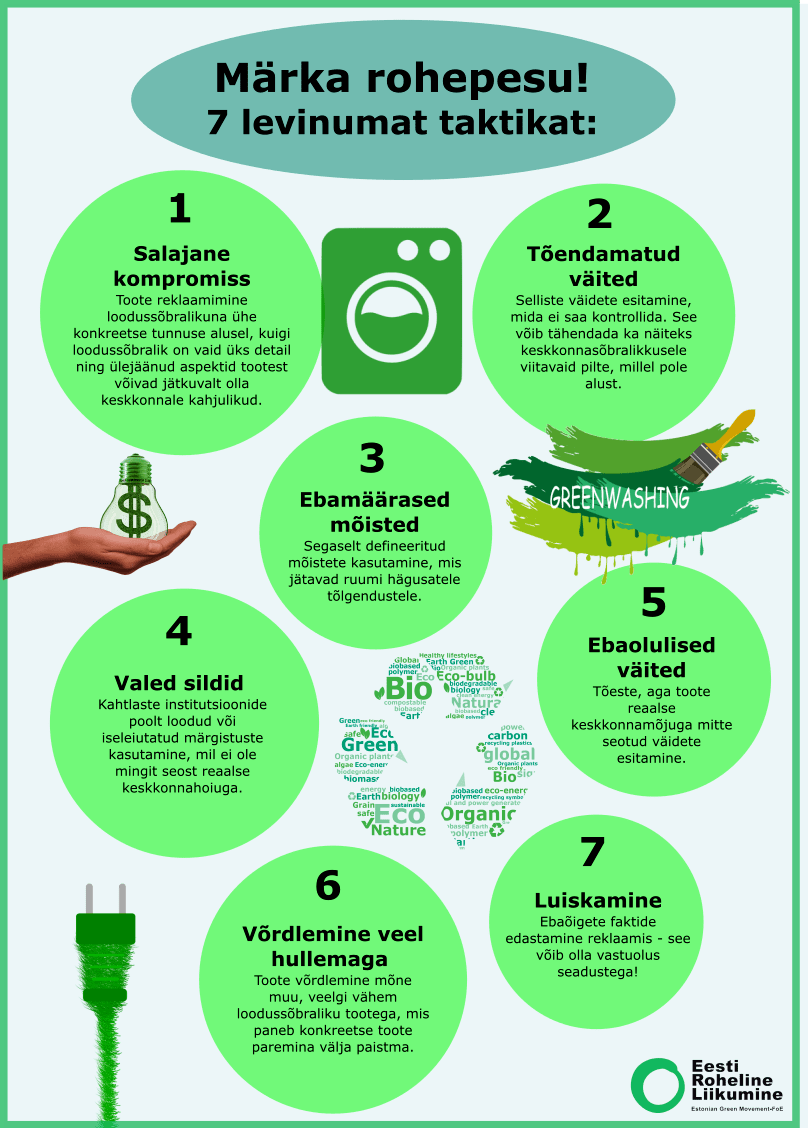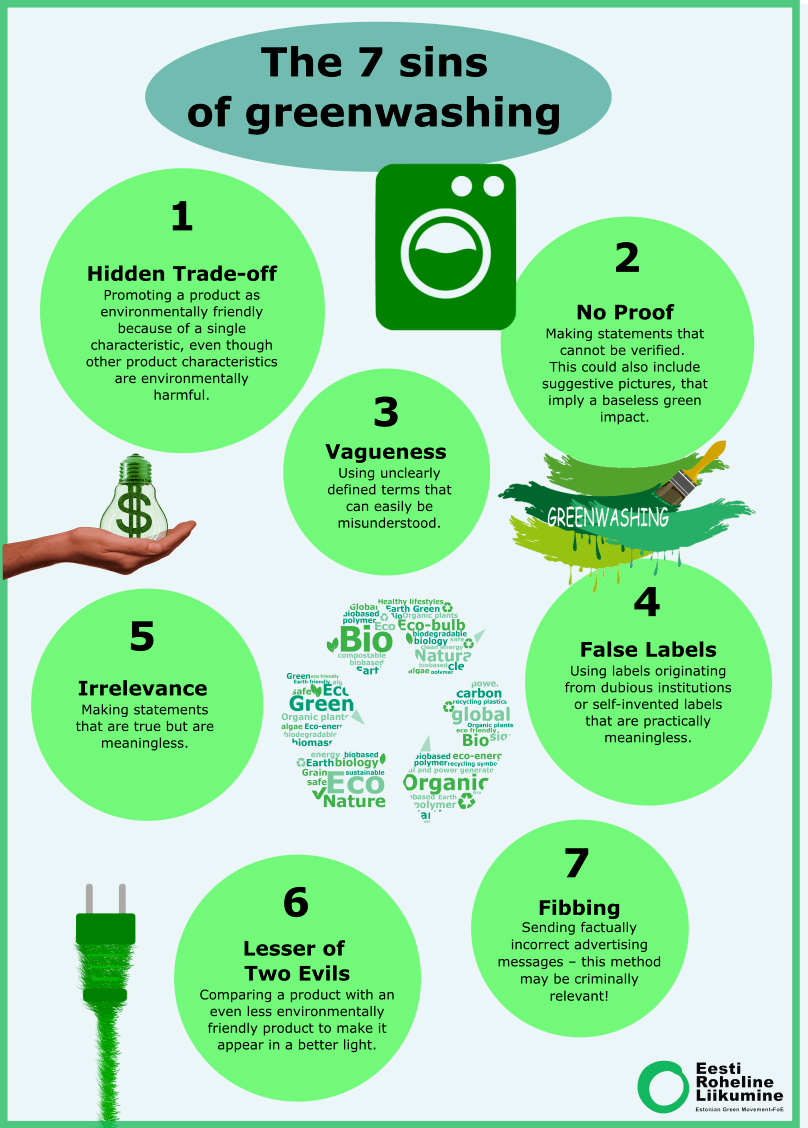Ära lase end petta! …ehk lühidalt ROHEPESUST (EST/ENG)

Autorid: Laura Bondl, Tabea Breidentach. Tõlkis: Kertu Leesmaa
Suured kiirmoeketid reklaamivad end vanade materjalide taaskasutajatena, kruiisilaevad nimetavad end “Rohekruiisideks” ja 99 sendi eest ostetaval kiletatud lihapakil on pilt seast rohelisel maastikul rõõmsalt ringi hüppamas – kõlab suurepäraselt, eks?
Faktidele otsa vaadates on ülaltoodud tegevused näited rohepesust, mis on loodud selleks, et tarbijat eksitada. See artikkel annab infot, kuidas rohepesu ära tunda ning mida Sina tarbijana saad teisiti teha. Nii saame tagasi õiguse oma ostukorvi sisu ise valida!
Mis on rohepesu ja kuidas see toimib?
Rohepesu on turundusstrateegia, mille autorid proovivad valeinformatsiooni abil panna ostjat tundma ennast ökoloogiliselt vastutustundlikku tarbijana. Läbi kommunikatsioonitehnikate – retoorika, manipulatsiooni – luuakse mingi ettevõtte toodetest positiivne kuvand ning seda paljudel juhtudel just tänu inimeste viimastel aastatel suurenenud teadlikkusele jätkusuutlikust eluviisist. Atraktiivne on tunda end “parema inimesena” ning tarbida kaupu süüvabalt. Paradoksaalsel kombel tarbitakse aga nii veelgi rohkem ning seeläbi kasvab rohepesuga tegelevate firmade käive ja turuosa.
Miks on rohepesu probleem?
Rohepesu veab inimesi alt ja võtab neilt otsustusvõimaluse kaupade ostmisel: inimesed usuvad, et käituvad oma väärtusele vastavalt (nt püüdes olla loodussõbralik), kuid tegelikult on neid lollitatud ning petetud firmade poolt, kes proovivad võita nende usaldusväärsust valelike meetoditega. Samuti meelitab rohepesu inimeste tähelepanu ära tegelikelt probleemidelt, nagu näiteks sotsiaalselt ja ökoloogiliselt õiglase tootmisprotsessi loomine. Seega liigub rohepesu ohvri fookus toodet ostes mujale, kui tegevustele, mis päriselt toetaksid globaalse vaesuse ja nälja vastu võitlemist, sealjuures negatiivse mõjude vähendamist nii inimeste tervisele kui keskkonnale.
Kuidas rohepesu ära tunda?
Ettevõtte ökoloogilist hoiakut hinnates on oluline selle pikaajalise strateegia ja perspektiivi läbinähtavus. Näiteks kui riidepood reklaamib intensiivselt orgaanilisi puuvillaseid särke ja samal ajal tunnistab, et see toode moodustab ainult 1% nende kogukäibest, kuid nende pikaajalisem eesmärk on seda osakaalu aastate jooksul kümnekordistada, siis võib firmat tõenäoliselt uskuda. Samal ajal tuleks aga hoida kriitilist meelt kõigi turundustegevusega loodud väidete, siltide ja sümbolite suhtes.
Mõnd ettevõtet saab usaldada ka range omapoolse kontrollita – neid, mida juba kontrollib mõni sõltumatu asutus. Kuigi jällegi, kahtlevale seisukohale tuleks jääda firmamärkide osas, mida saab hankida vaid kindlatest supermarketi kettidest või eraisikust müüjalt.
On olemas seitse enim levinud rohepesu meetodit, mida tasub teada:
Muidugi peab tunnistama, et loodussõbralik turundus ja sildistamine on ainus viis, kuidas päriselt loodussõbralikud firmad samuti näitavad oma pühendumust ja trumpavad üle teisi “rohepesu” ettevõtteid. On tarbija õigus valida enda jaoks toode, mille juures ta on teadlik selle ettevõtte võimalikest motiividest, mida sai eespool kommenteeritud. Ei tahaks ju häid inimesi karistada, eks?
Niisiis: võta initsiatiiv ja kontrolli nende toodete tausta, mida regulaarselt ostad ja tarbid. Otsi ja osta ametlike märgistustega tooteid. Selleks on olemas veebileheküljed ja äpid, mis Sinu valikud lihtsustavad, näiteks https://www.ewg.org/skindeep/ kosmeetika andmebaas.
Samuti on Sul vabadus ja õigus saata e-maile ettevõtetele, kelle tegevuse õigsuses Sa kahtled. Jaga ja toeta online petitsioone, mis antud teemat käsitlevad. Vii end regulaarselt kurssi selles vallas ringlevate uudistega ning mis kõige tähtsam – boikoteeri rohepesuga tegelevaid ettevõtteid ja jaga oma teadmisi oma sõprade ning lähedastega. Mida rohkem inimesi rohepesu vastu võitleb, seda suurem on tõenäosus seda vähendada!
Allikad:
https://www.euractiv.com/section/emissions-trading-scheme/news/scientists-call-on-eu-to-correct-biomass-carbon-accounting-rules/
https://www.dogwoodalliance.org/
https://stopgreenwashing.net/
darum-ist-greenwashing-ein-problem
https://de.wikipedia.org/wiki/Greenwashing#cite_note-2
https://www.vogue.de/mode/artikel/greenwashing
Don’t be fooled!
Greenwashing methods in a nutshell.
Authors: Laura Bondl and Tabea Breidentach
Big clothing manufacturers advertise that they use recycled materials, cruise lines are constantly marketing their “Green Cruises,” and on packaged meat for 99 cents, there is a picture of a pig on a green pasture, joyfully jumping around – sounds great, doesn’t it?
In fact, these are examples of greenwashing, which is intended to mislead you as a consumer. This article will show you how to recognise greenwashing and what you can do about it. Take back the power over your buying decisions!
1. What is greenwashing and how does it work?
Greenwashing is a strategy by which actors seek to create an image of ecological responsibility through targeted dissemination of disinformation. It uses techniques of public relations, rhetoric, and manipulation to create a positive perception of a company, its products, or its activities. Greenwashing works in many cases and also attracts consumers because awareness of sustainable living has increased in recent years. Many companies use this strategy to make their customers feel more comfortable about purchasing their products and to improve the image of their brand, which will ultimately lead to generating more turnover.
2. Why is greenwashing a problem?
Greenwashing tricks people and takes away the power of their buying decisions: While people believe they are acting in a way that is consistent with their values, they are fooled and betrayed by companies that want their trust but use unfair methods. And, of course, greenwashing distracts from actual problems and counteracts real transformations that are needed to establish socially and environmentally acceptable product manufacturing processes, which could help in curbing worldwide poverty and hunger as well as in ending damages to both health and the environment.
3. How can you identify greenwashing?
What is important is that a long-term strategy and a perspective are visible. For example, if the clothing store aggressively promotes organic cotton shirts while admitting that this product accounts for only 1% of sales, but, at the same time, show that their long-term goal is to increase this proportion tenfold in the next few years, there is a strategy behind it that can absolutely be appreciated. Nevertheless, you have to be wary about all those marketing claims, labels, and symbols. However, some seals can still be trusted without restriction, such as those that are controlled by independent bodies. One should be suspicious especially of seals that can only be found in certain supermarkets or on products from individual manufacturers.
Furthermore, there are seven so-called “sins of greenwashing” that are used by industries and companies to promote their products. You should know them to be able to identify greenwashing at first glance!

Of course, we also have to admit that green advertising and labelling is the only way for green companies to show their engagement and outdo other “greenwashing” companies. It’s up to the consumer to choose the product and to be aware of the possible motivations in the background – we don’t want to punish the good guys, do we? 😉
So take action and check out the products you buy and consume. Search for and buy products with official labels; there are websites and apps helping you with that (e.g. EWG Skin Deep (ewg.org) or the app, Think Dirty – Shop clean). You can also write emails with requests and pointed questions to the companies you accuse of greenwashing. Share and subscribe to petitions online that are handling the topic. Inform yourself regularly about news in this field and – this is the most important action – boycott “greenwashing” companies, and tell your friends and family about it. If we stand together, we will fight greenwashing! 🙂
Sources:
https://www.euractiv.com/section/emissions-trading-scheme/news/scientists-call-on-eu-to-correct-biomass-carbon-accounting-rules/
https://www.dogwoodalliance.org/
https://stopgreenwashing.net/
darum-ist-greenwashing-ein-problem
https://de.wikipedia.org/wiki/Greenwashing#cite_note-2
https://www.vogue.de/mode/artikel/greenwashing